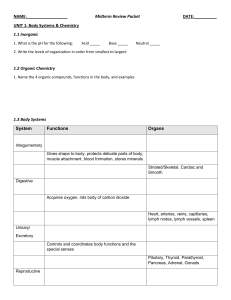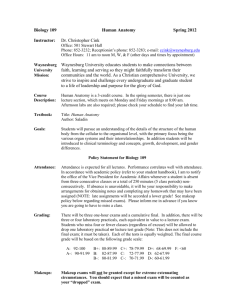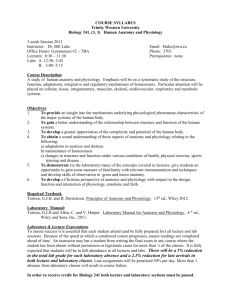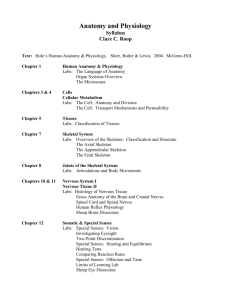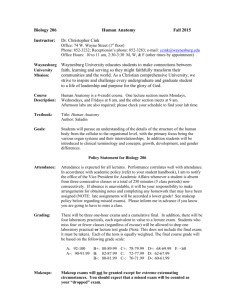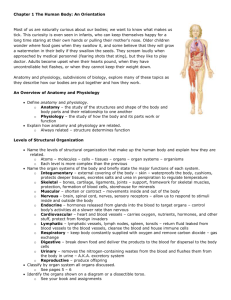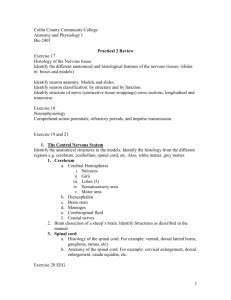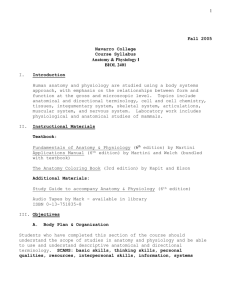sec 79425 - Syllabus - Spring 2012
advertisement
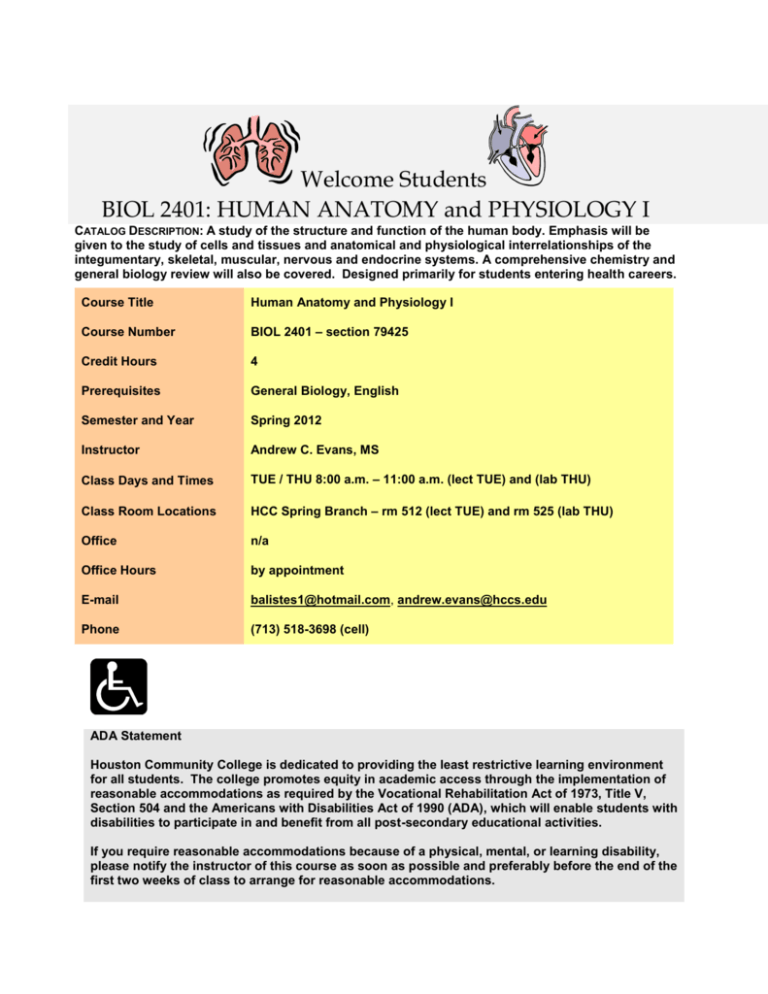
Welcome Students BIOL 2401: HUMAN ANATOMY and PHYSIOLOGY I CATALOG DESCRIPTION: A study of the structure and function of the human body. Emphasis will be given to the study of cells and tissues and anatomical and physiological interrelationships of the integumentary, skeletal, muscular, nervous and endocrine systems. A comprehensive chemistry and general biology review will also be covered. Designed primarily for students entering health careers. Course Title Human Anatomy and Physiology I Course Number BIOL 2401 – section 79425 Credit Hours 4 Prerequisites General Biology, English Semester and Year Spring 2012 Instructor Andrew C. Evans, MS Class Days and Times TUE / THU 8:00 a.m. – 11:00 a.m. (lect TUE) and (lab THU) Class Room Locations HCC Spring Branch – rm 512 (lect TUE) and rm 525 (lab THU) Office n/a Office Hours by appointment E-mail balistes1@hotmail.com, andrew.evans@hccs.edu Phone (713) 518-3698 (cell) ADA Statement Houston Community College is dedicated to providing the least restrictive learning environment for all students. The college promotes equity in academic access through the implementation of reasonable accommodations as required by the Vocational Rehabilitation Act of 1973, Title V, Section 504 and the Americans with Disabilities Act of 1990 (ADA), which will enable students with disabilities to participate in and benefit from all post-secondary educational activities. If you require reasonable accommodations because of a physical, mental, or learning disability, please notify the instructor of this course as soon as possible and preferably before the end of the first two weeks of class to arrange for reasonable accommodations. Course Learning Outcomes: BIOL 2401 Identify the important anatomical structures and features in each of the stated organ systems. Demonstrate an understanding of all important physiological processes of the stated systems and body structures, as well as fluid and electrolyte balance, nutrition, metabolism, pregnancy, human embryology, fetal development and human genetics. Describe the interrelationships between anatomy and physiology in each of the organ systems listed. Explain the principle of homeostasis and the primary control mechanisms that operate in each of the organ systems listed. Required Materials: Lecture: Principles of Anatomy and Physiology 13th Ed., Tortora and Derrickson Lab: Anatomy and Physiology 1 Laboratory Manual, 3rd Ed., Keating and Wiersema Evaluation: Lecture Grade: There will be 3 lecture exams in the course of the semester, as well as a comprehensive final exam. Exams will be scantron format. Each exam will include extra credit. Make-up exams will not be given. No exceptions. Lab Grade: There will be 2 hands-on lab practicals in the course of the semester. You will be required to turn in your lab write-ups, as they will make up a percentage of your lab grade. Makeup practicals will not be given. No exceptions. Final Examination: The final is comprehensive and mandatory. There will be no make–up on the final exam, period. This is a credit course. Grades will be assigned using the following table. I do not curve grades, period. Grading Scale: A 90-100 B 80-89 C 70-79 D 60-69 F below 60 Homework: There will be no graded homework. I will regularly hand out worksheets or review sheets to help you prepare for exams and practicals. I will regularly assign readings from the textbook. The readings are mandatory, and will be considered as fair game for test questions. You need to do the readings to gain a full understanding of the material. Class Participation and Attendance: Class participation is a reflection of your daily preparation and daily appendance. Students should come to class prepared, and able to participate in class discussions. Attendance to all classes is expected. Class attendance records will be kept to satisfy veterans and work program needs. An excessive number of absences will prohibit the successful completion of this course. If you should miss a class, it is the student’s responsibility to obtain lecture notes and assignments from a classmate. Also, if you aren’t going to be here, call me. If you are falling behind, I need to keep abreast of the situation, so we can work it out, and get you back on track. Make-up policy, repeated: Make-up exams will not be given for lecture or lab. No exceptions. Withdrawal Policy: Withdrawal from the course after the official day of record (see current catalog) will result in a final grade of “W” on the student transcript and no credit will be awarded. It is the student’s responsibility to initiate and complete a request for withdrawal from any course. I will counsel all students on their grades prior to this deadline, but, I repeat, it is the student’s responsibility to drop. I keep a current database of everyone’s grades, so you can come to me at any time, and I can give you your grades for the semester. Just as a note, a “W” has no bearing on your grade. If you are falling behind, or doing exceedingly poorly, it is far better to withdraw, and retake the course, than it is to get a “D” or an “F.” No stigma is attached to a withdrawal, but a failing grade is another matter. Academic Integrity: HCC is committed to a high standard of academic integrity in the academic community. In becoming a part of the academic community, students are responsible for honesty and independent effort. Failure to uphold these standards includes, but is not limited to, the following: plagiarizing written work or projects, cheating on exams or assignments, collusion on an exam or project, and misrepresentation of credentials or prerequisites when registering for a course. Cheating includes looking at, or copying from another student's exam, orally communicating or receiving answers during an exam, having another person take an exam or complete a project or assignment, using unauthorized notes, texts, or other materials for an exam, and obtaining or distributing an unauthorized copy of an exam or any part of an exam. Plagiarism means passing off as his/her own the ideas or writings of another (that is, without giving proper credit by documenting sources). Plagiarism includes submitting a paper, report or project that someone else has prepared, in whole or in part. Collusion is inappropriately collaborating on assignments designed to be completed independently. These definitions are not exhaustive. When there is clear evidence of cheating, plagiarism, collusion or misrepresentation, a faculty member will take disciplinary action including but not limited to: requiring the student to retake or resubmit an exam or assignment, assigning a grade of 0 for an exam or assignment; or assigning a grade of "F" for the course. Additional sanctions, including being withdrawn from the course, program, or expelled from university, may be imposed on a student who violates the standards of academic integrity. It is much better to fail a test, than it is to be expelled from school for cheating. Equal Opportunity Statement: It is the policy of HCC to provide equal employment, admission and educational opportunities without regard to race, color, religion, national origin, sex, age, or disability. HCC strives to provide an excellent learning environment free from harassment or intimidation directed at any person’s race, color, religion, national origin, sex, age, or disability. Any form of harassment will not be tolerated. You need to feel comfortable coming to class, in order to learn effectively. If anyone is harassing you, I need to know immediately, and I will take care of the problem. Biol 2401 Grade Sheet Test Test 1 Test 2 Test 3 Lab Practical 1 Lab Practical 2 Final Exam Lab Write-ups Optional Extra Credit Paper % of Total 16.67% 16.67% 16.67% 16.67% 16.67% 16.67% Variable (maybe test grade, maybe extra credit) up to 20 pts. added to a test Grade This sheet is for you to keep track of your grades. You may check with me at any time to verify grades. Please keep an ACCURATE accounting of your grades to know your standing. Course Outline: For each organ system, you should be able to ID and label all anatomical structures, describe the physiological processes in paragraph writing, and be able to associate and explain the physiological principles in a given condition or case study. Be able to ID the structures, functions and disease conditions of each system. Be able to explain in your own words the physiological interrelationships and principles of homeostasis among systems, and within each system. Know and understand the biomedical terms related to A&P. Course Calendar: Week of Jan 16 Jan 23 Jan 30 Class Topic Reference Chapters / Notes Introduction Ch. 1 - anatomical terms, structural hierarchical systems, properties of life, homeostasis, anatomical regions. LABS - lab safety lecture introduction to the microscope anatomical terminology and topography mitosis Ch. 2 - extensive chemistry and general biology review, incl. atomic structure, isotopes, valence shells, chemical bonding, electronegativity, chemical reactions, rate of RXN, catalysts, biochemistry, properties of water. LABS - microscopy of tissues Ch. 2 continued - extensive chemistry and general biology review, incl. acids and bases, pH scale, buffer systems, carbohydrates, lipids, proteins, nucleic acids. Feb 6 LABS - microscopy of tissues continued Take-home TEST 1 on TUE Feb 7 (over Ch. 2-3) Feb 13 LABS - microscopy of tissues continued integumentary system Ch. 3 - plasma membrane, cells as units of life, cell organelles. 1 2 2 3 Feb 20 LABS – REVIEW for LAB PRACTICAL 1 Ch. 4 - tissue histology, tissue types: epithelial, connective, nervous, muscular, tissue repair. 4 Feb 27 LAB PRACTICAL 1 on THU Feb 23 (over material covering up to integumentary system lab) TEST 2 on TUE Feb 28 (over Ch. 1, 4) Ch. 5 - integumentary system, accessory structures, glands, functions. Mar 5 Mar 12 Mar 19 LABS - skeletal system Ch. 6, 7 - bones, skeletal system, bone function and structure, cartilage, bone classification, chemical composition of bone, bone formation and growth, bone homeostasis, bone repair. Ch. 8 - overview of bones in the body, joint A&P, types of joints, classification. LABS - skeletal system continued SPRING BREAK – NO CLASS Ch. 9 - muscular system, muscle cell types, gross and microscopic anatomy, functions of muscles, skeletal muscle, cardiac muscle, muscle contractions. Ch. 10 - overview of muscles in the body. 5 6, 7, 8 9, 10 Mar 26 LABS - Skeletal muscle system continued TEST 3 on TUE Mar 27 (over Ch. 5-8) Ch. 11 - nervous system, neurons, neuroglia, synapses, neural transmission, action potentials. Apr 2 Apr 9 LABS - Nervous system Ch. 12 - nervous system, neurons, neuroglia, synapses, neural transmission, action potentials. Ch. 13, 14 - central nervous system, regions/lobes of the brain, functions of CNS, meninges of the CNS, spinal cord, peripheral nervous system, reflex arcs, types of reflex arcs, nerve regeneration, nerve fibers, sensory receptors, nerve ganglia, action potentials, impulse transmission. 11 12, 13, 14 LABS - REVIEW for LAB PRACTICAL 2 Ch. 13, 14 - autonomic and somatic nervous systems, ANS and SNS anatomy and physiology. 13, 14 Apr 16 Apr 23 Apr 30 LAB PRACTICAL 2 on THU Apr 12 (over bones and muscles) Ch. 13, 14 - autonomic and somatic nervous systems, ANS and SNS anatomy and physiology. Ch. 15 - special senses, hearing, vision, smell, taste, balance. Ch. 16 - endocrine system, major endocrine organs. 13, 14 15 16 May 7 REVIEW for FINAL Final Exam 8:00 a.m. – 10:00 a.m. THU May 10 (over Ch. 9-16, and comprehensive) All dates are subject to change with prior notice. It is your responsibility to stay informed as to any changes announced in class. Absence from class is not an excuse for failure to observe any announced changes. Good luck, and see you in class. Call me with any questions.

